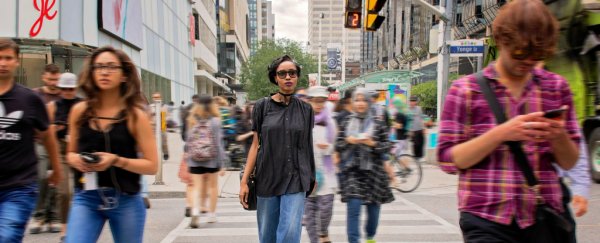According to an American study, people spend around 1.6 billion hours each year standing idly at the roadside, at the cost of US$2.6 billion to the American economy.
With all this waiting around, it's only natural to question whether pushing the "walk" button will help us get to our destination sooner.
To answer this question, we need to understand how the traffic lights work. Strict rules are applied within traffic control hardware to decrease the risk of collisions. For example, minimum times are set between one green light and the next, to ensure that vehicles can clear the junction safely.
While these timings are very important, they can place constraints on the operational efficiency of the junction. If you have ever driven through a city in the early hours of the morning, you'll know exactly what this means.
Despite there being practically no traffic on the road, you will still find yourself frequently stopping at red lights and waiting what can seem like an age for the lights to go green again.
Transport authorities recognise that delay is bad for all users. Idling vehicles contribute to air pollution, and making pedestrians wait does nothing to help government targets to increase the number of trips made on foot. Some towns and cities, such as Drachten in the Netherlands, are even experimenting by removing traffic lights, to improve traffic flow.
But in most places, the approach is to ensure traffic lights respond to the demands of those present, within the shortest time possible.
Meeting demand
For a simple pedestrian crossing, located away from a junction, the approach for dealing with pedestrian and traffic demands is simple. Press the button, and the green man or light will appear in due course.
How long you wait is a function of how long ago the crossing was last activated, the volume of approaching traffic and the policy of the transport authority.
Many authorities now prioritise pedestrians, meaning that provided a certain time has elapsed since the last demand for the crossing, the green man will appear almost immediately. If the button is not pressed, traffic will simply continue to flow indefinitely.
At an intersection, the situation depends on the design of the junction and the country you are in. In the UK and Ireland, most urban junctions with simple layouts operate on an "all stop" principle. In this case, traffic on all approaches to the junction is brought to a standstill to allow pedestrians to cross.
Like the basic pedestrian crossing, someone must have pressed the button, otherwise the green man will be skipped to reduce delays.
But there is a second junction type, which includes what are known as "parallel" or "walk-with-traffic" pedestrian crossings. In the UK and Ireland, this is achieved on more complex junctions through clever separation of traffic lanes and turning movements, allowing pedestrians to cross while traffic continues to flow.
In continental Europe and cities such as New York, and in other parts of the world, different traffic rules apply, meaning drivers must give way to pedestrians when turning. This makes it easy to implement parallel pedestrian crossings, on even the most basic junctions.
For these junction types, as the pedestrian demands are served at the same time as traffic, in most cases the green man will usually appear regardless of whether the button has been pressed.
The only time the button may need to be pushed is during periods of very low traffic volumes, or where the pedestrian crossing – if unused – would inhibit the efficiency of the junction.
At all crossings though, the button only ever needs to be pushed once. Due to the operational rules, pressing it many times or holding it in will not make the green man appear any sooner - even if it may seem that way when you're in a rush.
To wait or not to wait?
Faced with the prospect of a stand off with the dreaded red man, the impatient pedestrian has a couple of options. Due to the absence of jaywalking laws, many Britons choose simply to cross the road anyway (hopefully only when it is safe to do so).
But in places such as Germany, it is the law and the cultural norm to wait for the green man, regardless of traffic - or indeed the lack of it.
With all this waiting around, it is perhaps unsurprising that the ever-pragmatic Germans have come up with a way of killing time, through the installation of push-buttons featuring miniature video games at certain locations.
![]() So the next time you find yourself waiting at a crossing, perhaps rather than fuming at the delay, try to think of ways to make the most of it. But don't forget to press the button – just in case.
So the next time you find yourself waiting at a crossing, perhaps rather than fuming at the delay, try to think of ways to make the most of it. But don't forget to press the button – just in case.
Richard Llewellyn, Lecturer in Transportation Engineering, Edinburgh Napier University.
This article was originally published on The Conversation. Read the original article.
